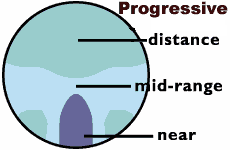|
Far sighted |
Near sighted |
Astigmatism |
|
 |
 |
 |
|
Light rays focus behind the retina (back of the eye like the film in a
camera) |
Light rays focus in front of the retina |
Some light rays focus in front of the retina and some behind. |
|
REMEDY |
|
|
|
 |
 |
 |
|
The eye can focus the lens to remedy small and equal amounts |
Near objects can be seen well, all distance objects are blurred. Squinting
helps distance vision some. |
The blur is always present. |
|
TREATMENT |
|
|
|
 |
 |
 |
|
plus lens |
minus lens |
cylinder lens |

Eye protection guide\ Drivers
I've read there are documented cases of airbags deploying and breaking the
drivers eyeglass lenses. Polycarbonate lenses are the strongest and safest
optical lenses especially if you are smaller in stature or sit close to the
steering wheel.
Sports: every 13 minutes a person with a sports related eye injury
visits an emergency room so if your favorite sport involves any kind of "ball"
,an object which soars through the air, or involves velocity; Polycarbonate
lenses are the strongest and safest optical lenses. Recommended eye protection
for:
Baseball - ASTM standard F910 faceguard attached to the helmet
Basketball, Field hockey, soccer, Volleyball - ASTM standard F803
Football - Polycarbonate eye shield attached to helmet
If you answer yes to any of the following it is recommended that your
eyewear always contain polycarbonate lenses.
Suffered previous eye injury____
Have ocular implants_____ Vision in
only 1 eye____
Eye disease_____ Over 65 years of
age____
*ASTM is an abbreviation for American Society for Testing and Materials
If you have any questions regarding your prescription, type of lenses, or
lens materials please contact our office at 708-686-5266.
Lens types: Single vision Bifocal Progressive Lenses Trifocal Occupational
Single vision lenses correct for only one purpose. To see clearly and sharply
at a distance or to read up close.
Bifocal lenses are designed with two focal points: the top portion of the
lens provides clear sharp vision at a distance (approximately past your armís
reach) and the bifocal region which is shown with a line allows you to read at a
distance range of 16 -21 inches.
Progressive lenses have the unique capability to provide you with clear sharp
vision at a distance, a mid range, and read up close. There are over 50
different varieties of progressive lenses. And it is very important your eye
care provider know exactly what type of mid range and close work activities your
eyes are engaged with. Progressive lenses are very sensitive to the distances
you work at and higher prescription strengths.

Trifocal lenses are designed with three focal points: the top portion of the
lens provides clear sharp vision at a distance (approximately past your armís
reach), the middle portion is designed for distances between 22 - 28 inches and
the bifocal region allows you to read at a distance range of 16 -21 inches. This
type of bifocal is characterized with two lines and is very sensitive to the
distances you work at and higher prescription strengths.
Occupational lenses come in a variety of designs. For example one type of
occupational lens has a bifocal region on both the top and bottom portion of the
lens. Three types of progressive lenses are available for computer users; even
those who donít regularly wear glasses of any kind.
Lens materials: Glass CR 39 Plastic Polycarbonate High Index Trivex
Glass is the oldest material to make eyeglasses. On the plus side glass
doesnít scratch as easily and is available in a variety of standard tints. This
lens material is ideal for welding for the surface doesnít burn and employees
who grind find it is more resilient to scratches. On the negative side the lenses
are very heavy. Also glass lenses with a photosensitive tint stay darker and
darker indoors as they age thus interfering with clear sharp vision indoors and
nighttime driving. Some progressive lenses are not made in glass.
CR 39 plastic provides optical qualities similar to glass. On the plus side
CR 39 plastic is light weight, easily tinted in a wide range of colors including
Transitions, and most progressive bifocals are available. Unlike polycarbonate;
CR 39 is not adversely effected by harsh chemicals On the negative side
CR 39 plastic is easily scratched and tints can fade.
Polycarbonate is light weight, has a built in UV filter, and automatically is
made with a grey tint. On the plus side polycarbonate has a higher safety factor
than glass or CR 39 plastic. Polycarbonate lenses can be tinted in a limited
range of tints and is available in Transitions. Most progressive bifocals are
available in polycarbonate. On the negative side polycarbonate lenses cannot be
used in certain industrial environments as they can be permanently fogged by
certain chemicals. Polycarbonate lenses are stronger than CR 39 plastic when it
comes to scratching but can be scratched.
High Index is the solution for individuals with very high prescriptions to
limit both the weight and thickness of the lenses. High index has all the
features of polycarbonate. On the negative side High index lenses require a
period of adjustment to the prescription as it can alter images due to its Index
of Refraction.
Trivex is the latest technological advancement in lens materials. Similar to
polycarbonate; on the plus side this lens, when approved, will be available in
2.0 mm. thickness versus the current OSHA standard of 3.0 mm. This can greatly
improve the comfort of safety glasses by reducing the weight factor. Trivex is
not currently available in all prescriptions and bifocal types.
home
![]()
![]()
![]()
![]()
![]()
![]()
![]()
![]()
![]()

